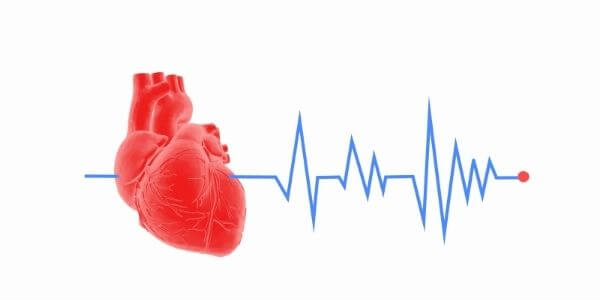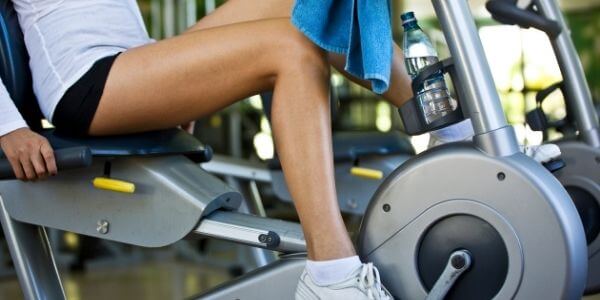Recumbent bikes activate your lower body, improve your stamina, circulation, and your mood. We’ll explain these benefits and others below.
Recumbent bikes are widely used during rehabilitation programs by mobility-challenged people and those with chronic pain. Even some athletes use them to complement their routines.
However, recumbent bikes have a particular set of risks you should beware of. We’ll discuss that below too, but first:
Table of Contents
8 Advantages Of Recumbent Bikes
In this section, we’ll analyze various advantages of recumbent bikes. We’ll cite the science, explain everything, and tell you what to look out for.
1. Heart Health

Using a recumbent exercise bike benefits your heart health because it makes your heart stronger. At the same time, challenging yourself properly improves your breathing and decreases your resting heart rate.
Thus, if you have high blood pressure, know that that pressure will decrease over time.
Even if you don’t have blood pressure problems now, having a weak heart can lead to many issues. That’s why you need aerobic exercise to keep your heart healthy.
There’s research to back that claim and studies show that using a recumbent bike is as beneficial on your heart and muscles as resistance training.
That leads us to:
2. Increased Muscle Strength
Working out on a recumbent bike benefits muscles. Double-check the study above, which proves this type of exercise can shape your lower body. Many other studies certify the same thing: recumbent bikes will improve your lower body strength and functionality.
Now you can ask this question:
Aren’t upright bikes better for lower body toning than recumbent bikes?
Not according to our research. For example, this study shows that both types of bikes work the same muscles in your legs.
The only difference is that recumbent bikes work your hamstrings and shins harder. Conversely, upright bikes exercise your quads and core more intensely.
3. Improved Range Of Motion

Working out on a recumbent bike will improve your flexibility and overall functionality. Thus, you’ll be able to move more, lift your chair more quickly, and stretch for that remote when your pup fell asleep in your lap again.
Here’s the gist of it:
When you’re pedaling on a recumbent bike, your blood circulates faster so that your tissues become more elastic. This elasticity translates as flexibility or ease of movement.
These facts are documented and proved. That’s why many physical therapists recommend including recumbent bikes in various rehabilitation programs, along with manual therapy.
The benefits of a recumbent bicycle on your blood circulation and flexibility mean you can alleviate the symptoms of arthritis or hip pain.
4. Comfort
Recumbent bikes are much more comfortable than upright bikes. Just imagine resting on those large, plush seats. You won’t experience any tailbone pain even after an hour of intense workouts.
Enjoying your workout is essential if you want to keep your motivation levels up.
Besides, you – like a lot of people – may not want high-intensity exercise. If you prefer to keep things low, whether because you’re mobility challenged or that’s just how you jam, a comfy recumbent bike will make the time pass quickly. You can relax with a good TV show or a gripping book and keep in shape while you’re doing it.
5. Brain Health And Relaxation

Working out on a recumbent bike increases your brain’s oxygen intake to take better charge of its job, which keeps you happy and functional. So the brain will regulate your hormones and overall organ activity to reduce stress and stabilize your mood. You’ll even sleep better and wake up more rested.
Besides, if the brain is well fed and happy, you’ll say goodbye to that brain fog or stuffed head feeling. That’s how you can be more productive, improve your relationships, and enjoy your life more.
6. Upscaling Options
Most recumbent bikes on the market have a slew of programs and options to personalize your workouts. For example, you can change resistance or intensity settings to fit your fitness level or just your general mood for the day.
Some models also have virtual training so that you can pedal away on international routes. You can also connect your bike to specific apps to track your stats and progress.
That means you can adapt and scale up your workouts on a recumbent bike every time you feel like it. Some trainers even recommend their athletes to use recumbent bikes.
That’s helpful to know because you may want to share this recumbent bike with other people in your home. So luckily, you can adjust your bike according to everyone’s fitness levels, goals, and preexisting conditions.
7. Safety

One of the critical benefits of riding a recumbent bike is its safety.
This type of exercise protects you from in-workout injuries because it doesn’t stress your joints, lower back, and hips. That means those training for rehabilitation purposes or the elderly can stay safe while also improving their strength.
Then there’s the balance issue.
Sure, you can have a mobility-challenged person hop on an upright bike to gain more flexibility, endurance, and strength. But if their conditions are severe, they might lose their balance and fall off.
Instead, recumbent bikes are very safe because the risk of falling off one of those is minuscule.
And here’s another thing:
Everyone praises the effects of aerobic exercise on heart health. However, not everything aerobic is excellent for your heart, and you should know that certain conditions impose extra care before starting a workout regimen.
That’s why we always advise you to consult with your doctor before trying on new fitness equipment.
That said, research shows that working out on recumbent bikes is safe for individuals with specific cardiac issues.
8. Weight Loss
Riding a recumbent bike benefits weight loss if you’re setting the bar low. You can expect to burn about 150 calories for every 30 minutes of exercise at medium-high intensity.
However, these numbers depend on your current weight, age, and exercise intensity. Heavier and younger people who pedal harder will burn more calories than petite, older individuals who practice low-intensity pedaling.
So, for example, if you’re pedaling leisurely and you’re a 100-pound 60-year-old person, you can expect to burn just 70-80 calories/ 30 minutes.
3 Recumbent Bike Disadvantages

Choosing a recumbent bike comes with a particular set of risks because this type of bike is so comfortable. Sure, people in rehabilitation, the elderly, people with arthritis or degenerative disc disease will appreciate the oversized chair and design.
However:
1. You won’t get any upper body and core work. That means you’ll have to try and find specific exercises that train your arms, lower back, and abs according to your preexisting conditions. For example, you can do some strength training on your own or choose a recumbent bike with resistance bands to exercise your arms.
2. You won’t increase bone density. Recumbent bikes take all the pressure away from your joints and bones. While that makes recumbent bikes safe, it also makes them the complete opposite of weight-bearing exercise. And as you know, weight-bearing exercises increase bone density to alleviate or prevent chronic issues like osteoporosis, arthritis, etc.
3. You won’t lose lots of weight. Recumbent bikes – even when you’re working hard – are still mellow enough compared to upright bikes, spin bikes, or treadmills. Thus, you won’t lose a lot of weight or sculpt your midriff, though you will be able to control your weight better.
In Conclusion
Recumbent bikes have lots of benefits. They’re comfortable and easy to use, plus they have proven benefits on rehabilitation, muscle toning, and range of motion.
Recumbent bikes aren’t excellent for quick weight loss and total body training, though. However, you can find models that include resistance bands to work out your upper body. If you want to lose weight faster, make sure your recumbent bike can go more quickly and at higher intensities.
And remember to never compromise on quality – you can find plenty of affordable models that will mold to your needs.
- 7 Exercises for Pregnant Women in the First Trimester: Safe and Effective - January 30, 2025
- Our equipment recommendations - October 30, 2024
- Here’s What Doing Cardio Every Day Does To Your Body - August 21, 2024

